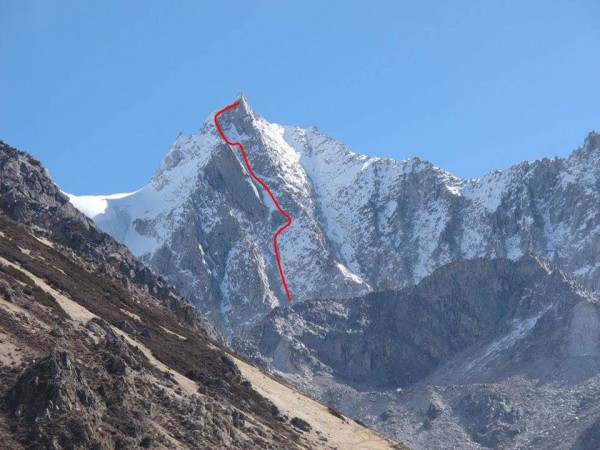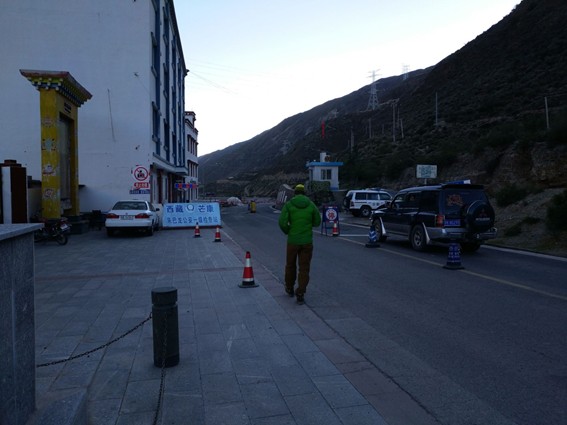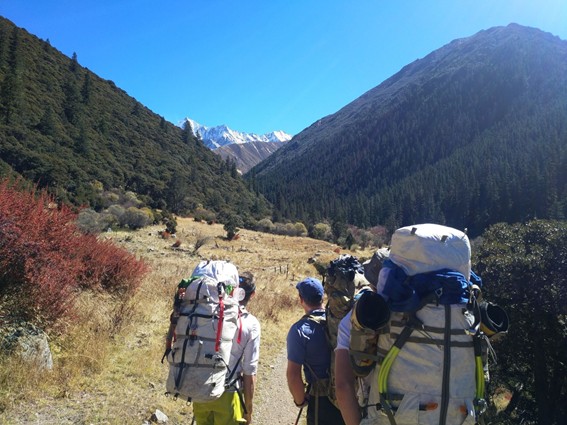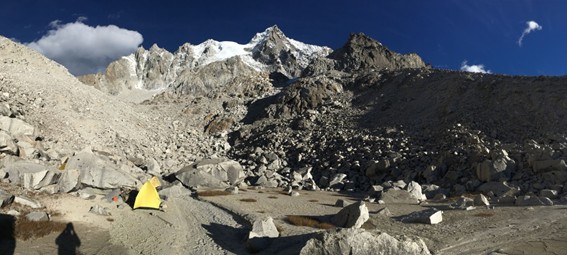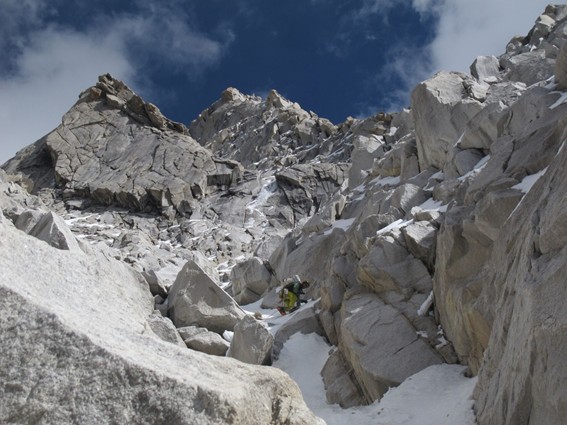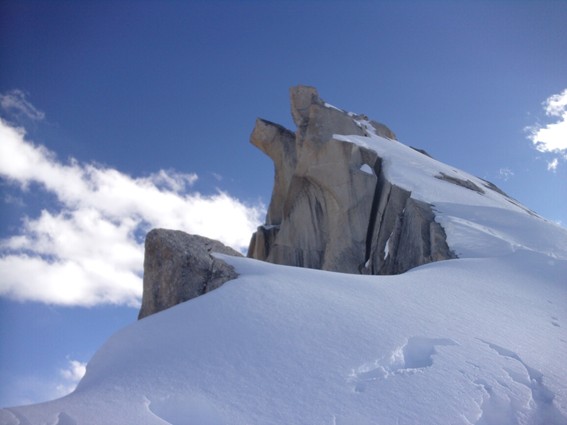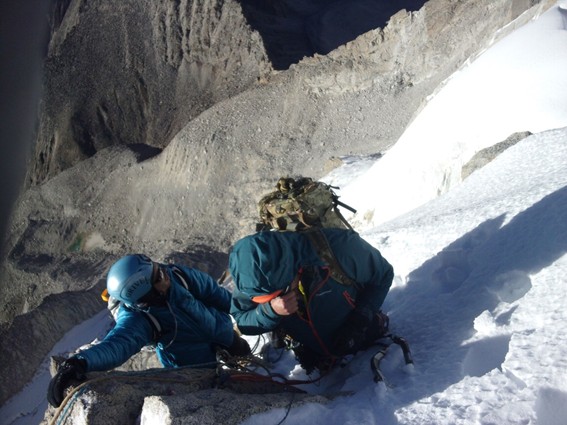During unbroken perfect weather from late October to early November we made the first ascent of the previously undocumented 5625m Xialong Rezha (unnamed and incorrectly marked as 5851m or 5346m by some sources) to the west of the Ge’nyen massif in the Shaluli Range, Sichuan. A quintessential Eastern Himalayan peak, Xialongrezha is the closest +5500m peak to the near-completely closed border to Xizang province, Tibet (see http://www.alpinist.com/doc/web16f/newswire-british-alpinists-climb-a-virgin-north-face);,
Relatively well known, the eastern and central areas of Ge’nyen have been visited regularly for over a decade, including ascents by Sarah Hueniken, Dave Anderson and Joe Puryear, with Mt Ge’nyen itself first climbed in the 90s by a Japanese team. That our trip coincided exactly with the 10th anniversary of the deaths of Charlie Fowler and Kristine Boskoff wasn’t lost on us.
the western side of the Ge’nyen mountains is accessed via 4 days travel along the Sichuan-Tibet highway from Chengdu via Kangding, Xinduqiao, the ‘Tibetan Disneyland’ town of Litang and the border town of Batang, then a small road over a 5000m pass almost unknown even to the locals. 25km from the upper Yangtze that forms the administrative border, Xialongrezhe is prominently visible from the small hamlet at the end of the road, the name translating as ‘place of big horned animals and large boulders’,
We planned to do a first ascent with no additional support, something developed over many previous trips to western Sichuan/eastern Tibet. going into undocumented terrain completely self-sufficient, our only limitation was the loads we could carry, acclimation and the weather, having banked on the dependable early winter window directly after the last squall of the south Asian monsoon and before the first snows arrived. This year didn’t disappoint, with an unbroken string of 15 days without any form of precipitation.
BC I was several kilometers from the village thru a beautiful pine and lichen forest to a sunny vale at 4200m. a pastoral delight, with clear aquamarine rushing streams, flocks of pheasants and lazy yaks, we did sorties higher up and after 3 nights to consolidate decided to move the entire BC up to 4900m rather than just a light ‘assault bivy’. This involved heavy carries up several kms of marsh, bouder fields and scree.
BC II was a true high Tibetan location; stark and lunar. By a small glacially fed lake, the high moraine and room-sized boulders showed no signs of visitation aside from thirsty antelope and small, colourful birds. The difference between direct sun and shade was a +20c and -10c differential that bookended each day.
From vantage points along the approach it was clear the premium route on the west face was the jilted central couloir. we juggled thoughts about various other route alternatives but confirmed the central couloir after a recce day onto the glacier beneath.
as the route was steep, our acclimation at threshold and the amazing weather window getting on, we lead in blocks, seconding together for speed. With good team work, good rock and solid snow this worked efficiently.
after soloing the 90m glacial snout to the couloir’s base cone, Mitch powered us thru the next 3 pitches, then Ed lead up to and around where the couloir changed direction, including a long double pitch with a vigorous traverse. This was followed by Rob launching up 5 run-out pitches on lessening snow quality that ended in a pitch dug thru to the slab below to the cornice on the summit ridge. a further half pitch by Ed confirmed the sketchy snow and serious fall potential, leaving the bizarre summit formation unclimbed out of respect for sanity and local Tibetan lore.
The couloir presented no good options for bivies so all 12 pitches were climbed in a single push, non-stop effort on new terrain.
Experience from previous trips had us carrying an array of alpine pro, but we ended up using a time-proven rack of small to mid cams and wires, beaks and pitons and an occasional screw. aside from the upper two pitches the snow was excellent, with ice a mix of glacial and alpine. rock in the western cluster is A grade granite, fissured with finger to hand width cracks splitting contiguous slabs and faces topped wild gendarmes, gargoyles and features.
Chopping thru the cornice we could see eastwards into the main Ge’nyen area, with 6200m Mt Ge’nyen and other +5500m peaks clearly visible. Westwards, in the other direction, we could make out long ranges of robust peaks over 6000m beyond the closed Tibetan border.
At 16:00 we began the many rappels that would get us back to camp at 22:00.
Continuing the good weather streak we spend the following day laying on sun-warmed granite boulders and eating, before starting the heavily loaded return to the village where we were welcomed by the local monk and school kids. Returning to Batang we consumed the hotels entire supply of roast duck.
the team consisted of organizational legend Zhang Jiyue, sharp-end expert Alex Tang (China) and climbers Mitch Murray, Rob Baker & Ed Hannam (Australia).
This trip was entirely self-funded, with no sponsors, no grants, no awards and no film deals, though a special thanks goes to Sea to Summit for their sleeping mat solutions, and to Cilogear for producing the unique packs that made the unsupported nature of the trip doable.
